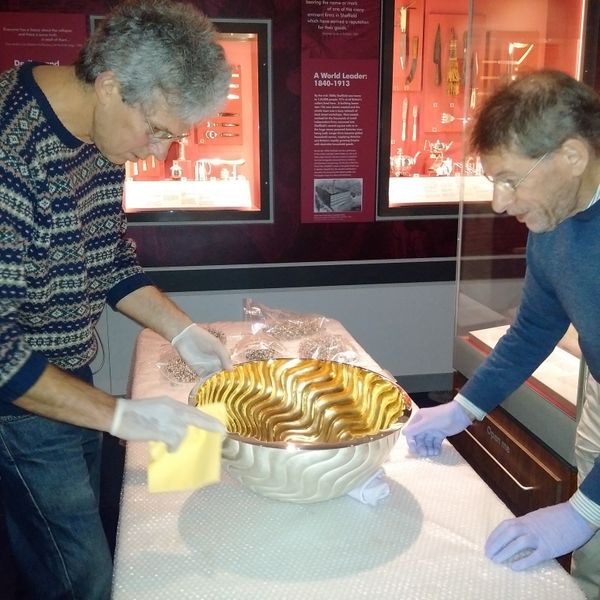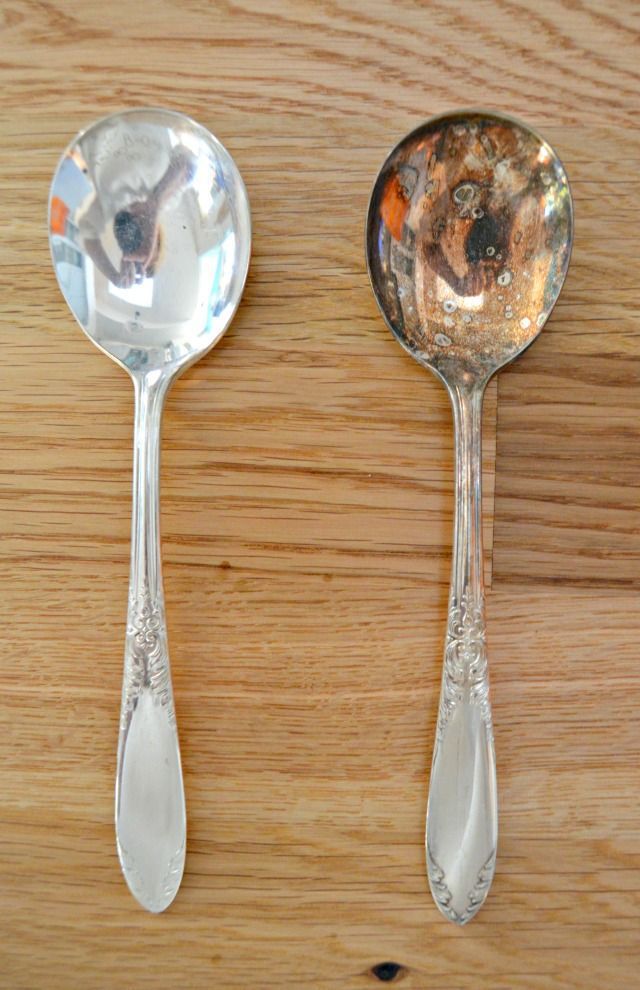Ever wondered - Why does silver tarnish?
Published: 16th January 2020

The Sheffield Assay Office has a collection of over 1000 pieces of silver and silver plate, dating right back to the very first year of the office in 1773 and spanning the centuries right up to the present day. Each year a commission is made to add to the collection, much of it made locally in Sheffield.
From the most elaborate and ornate historical objects to the stunning simplicity of contemporary pieces, the collection is cared for and regularly cleaned.
Many of these items are on display to members of the public who visit us as during our popular Tours & Talks, and one of the most frequently asked questions by visitors is “how can I stop my silver from tarnishing?”.
To answer this question, we first need to know how silver tarnishes and which conditions to avoid.
So why does silver tarnish?
Sterling silver is an alloy of silver and base metals such as copper; the copper reacts with sulphur-containing gases in the air to form a layer of the compound copper sulphide (Cu2S). Pure silver is less prone to tarnish, but will still react to form silver sulphide (Ag2S).
The colour of tarnish on silver changes as tarnishing proceeds. This is due to a phenomenon called “thin film interference.” As light hits the thin film of tarnish on the silver, it splits; some of it reflects off the top surface, and some of it reflects off the silver under the tarnish. When the light from the top and the bottom of the tarnish recombines, some of the colours are lost through interference. The colour that remains depends on the thickness of the tarnish layer. In the early stages of tarnishing, as the thickness grows from 10 to 100 nanometres (nm), the colour changes from yellow through red-brown to blue. For thicknesses greater than about 100 nm, the colour is black, the true colour of silver sulphide.

Some modern silver jewellery is deliberately oxidised using sulphur containing compounds to give it an “antique” look.
The rate that silver tarnishes depends on the concentration of sulphur-containing gases in the air. The most common sulphur-containing gas is hydrogen sulphide (H2S). In a museum setting, where a dark layer of tarnish may take months or years to form, the hydrogen sulphide concentration is typically between 86 and 600 parts per trillion. If you dip a silver spoon into the sulphur rich yolk of a hard-boiled egg, it will tarnish almost immediately.
Relative humidity also affects the tarnishing rate. For a given concentration of hydrogen sulphide, silver tarnishes faster as the RH climbs. Ideal conditions are where the relative humidity is below 50%.
Fingerprints and perspiration (or sweat) from hands contain salts, oils, moisture, etc., that easily transfer onto metal surfaces and can lead to noticeable corrosion, especially on polished metal surfaces. Sodium chloride (salt) from fingerprints reacts with silver to form silver chloride, which is light sensitive and can darken over time, resulting in fingerprint stains that are highly visible and obtrusive on polished pieces.
The materials used for packaging can also promote tarnishing. High sulphur and other tarnish-causing compounds released from paper, cardboard, foams and adhesives are a common problem. When an item is packaged in a small, enclosed box or case with sulphur-releasing agents, the levels of sulphur can become much more concentrated.
The Sheffield Assay Office has devised two test methods which can assist manufacturers and suppliers in their efforts to prevent their goods from tarnishing before they are sold. The Accelerated Tarnish Test measures how likely a silver alloy is to become tarnished. This is useful for testing new jewellery alloys or coatings. The Packaging Test measures the effect that any packaging has on the rate at which silver tarnishes. For more information about these tests, please contact our Analytical Services division.
Since most of us don’t live in museums, what can we do to slow down the rate at which our silver tarnishes?
Store it the right way
For those items which are not often used or worn, make sure you keep them in dry conditions. Save up those ‘Do Not Eat’ silica gel sachets and keep them with your silver, or a couple of pieces of chalk will also do the trick. These will help to absorb some of the moisture in the atmosphere. Damp basements and attics are a definite no-no.
When storing silver, use special tarnish-reducing bags and jewellery pouches to protect silver from dust and scratching. Do not wrap silver in newspaper as this will rapidly tarnish it, nor seal in bubble wrap or plastic as these trap moisture.
There is also a range of special silver cloth available which is embedded with fine silver particles. This is designed to protect the silver article and can be purchased on a roll to wrap your objects in. Cutlery or jewellery can be stored in pouches made of this impregnated cloth. Storing silver in wooden draws or cabinets can accelerate the tarnish process. Anti-Tarnish blocks or Anti- Tarnish strips can be used in display areas or within storage vessels.
Use it wisely
Avoid contact with sulphur-heavy items and foods. Rubber gloves and bands, wool and elastic items contain higher levels of sulphur and tarnish sterling silver faster. In addition, eggs, salad dressings and onions also speed up the tarnishing process.
If you do use silver objects for serving food and dining, wash the items separately using plastic bowls. Rinse in clean warm water and dry immediately to reduce the rate of tarnishing.
It goes without saying that you should remove your jewellery when going swimming or bathing, doing the housework, gardening, DIY or relaxing on the beach. Also avoid chemicals such as perfume, hairspray, body lotions, and foundations etc. which may corrode the silver and also make its surface more prone to tarnish.
Handle it with care
The truth is that even if you avoid these triggers, your silver will become tarnished over time.
Tarnish grows more quickly on silver that has been freshly polished than on silver that has already tarnished. Thus a layer of tarnish, as unappealing as it might appear, actually helps to protect the silver against further tarnishing. For this reason, it is usually recommended that tarnished silver be left unpolished unless cleaning is required for exhibit or display.
The Millennium Punch Bowl (main picture) was commissioned by the Sheffield Assay Office and is a unique collaboration by four designer-silversmiths: Alex Brogden, Chris Knight, Brett Payne and Keith Tyssen. It is currently on loan to Museums Sheffield, and is a fantastic example of local silversmith talent, but is only cleaned once every five years.
When handling silver, use thin vinyl or cotton gloves. Our hands leave oils and moisture on the surface, which mark and promote tarnish. You should first remove dust lightly with a lint-free soft cotton cloth, or use a soft-bristled artist’s brush, covering the metal ferrule with tape to prevent scratching of the surface.
To prevent surface damage and excessive wear, clean silver with the correct materials, as infrequently as possible There are many commercially available products in the form of pastes, dips and cloths. A quick search on the internet will also provide you with many weird and wonderful ways to clean your silver, but be aware that they may have consequences. Aluminium foil, baking soda, toothpaste, detergents and vinegar are all common remedies but may all cause long term damage to both the silver and any gemstones if used frequently.
Light cleaning with specialist silver cloths will avoid the need for abrasive cleaners. The golden rule is 'gently does it'. As you clean, consider the overall appearance of the piece. In some cases, such as pieces with relief decoration, removing all tarnish can leave a piece looking lifeless. You don't necessarily want a spotless surface. Step back at regular intervals and look at the object as a whole - you may wish to leave some tarnish behind to visually define the design.
So in conclusion there is no magic formula to follow, however a bit of gentle care and attention will work wonders in keeping your precious silver looking as good as the day you bought it.
The Sheffield Assay Office was established in 1773, under an Act of Parliament and today the company assays and hallmarks the precious metals - silver, gold, platinum and palladium. Sheffield Assay Office is one of only four UK assay offices who all work to uphold the Hallmarking Act of 1973 and continue to ensure consumer protection for customers purchasing precious metals.
To find out more about the whole range of services offered by Sheffield Assay Office, such as our hallmarking and analytical services, please email us at info@assayoffice.co.uk or complete the contact form on our website at http://www.assayoffice.co.uk/contact-us ,
Sign up here to all the latest news from Sheffield Assay Office direct to your inbox